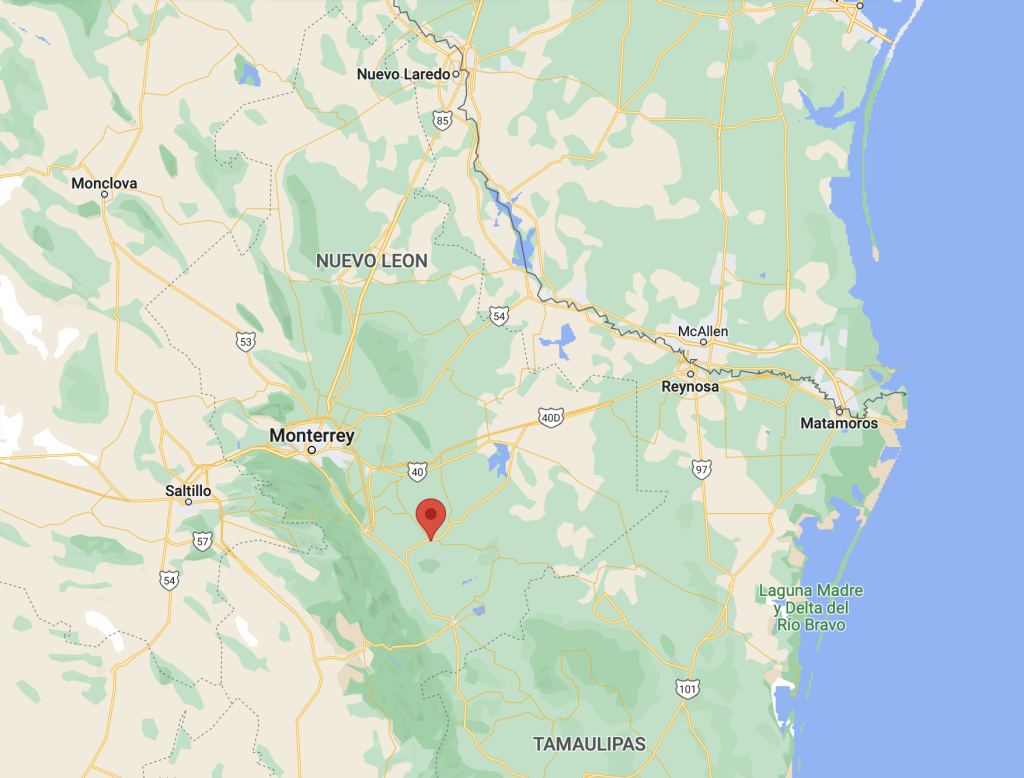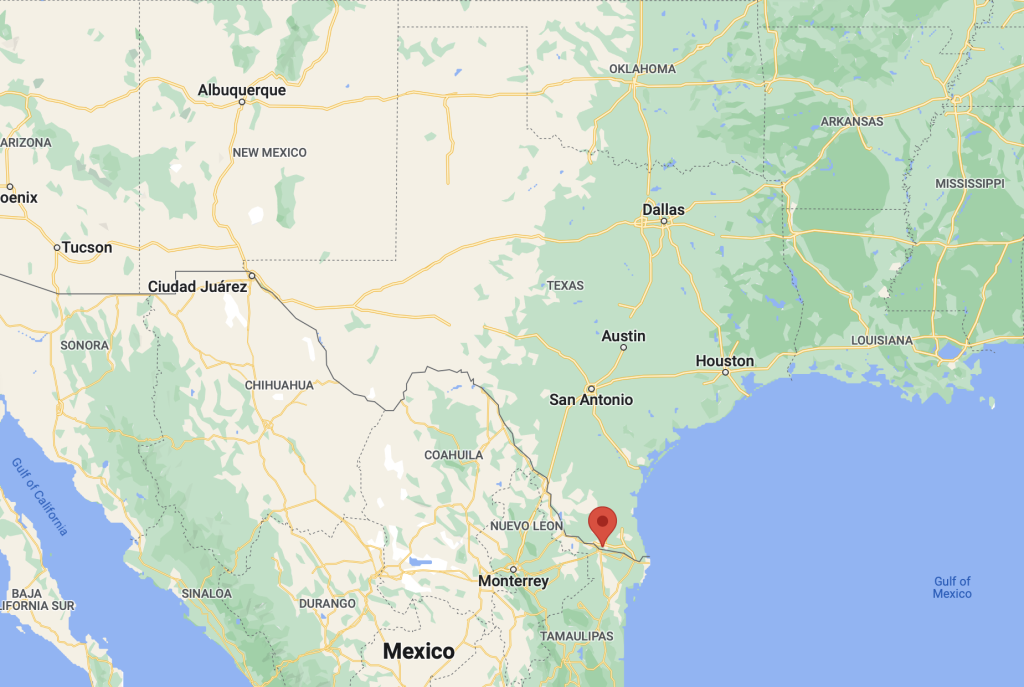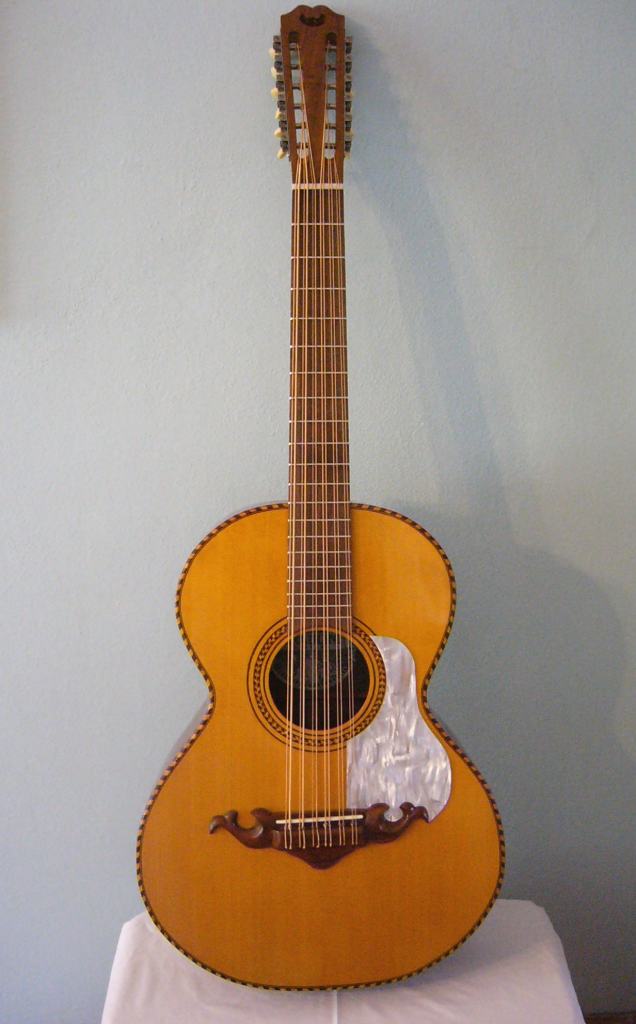
Formed in the mid-1940s by Mexican musicians Eugenio Abrego and Tomás Ortiz, Los Alegres de Terán was a música norteña duet whose songs helped to popularize the sound of traditional norteño music. The duo is originally from Mexico, where they met and began making music together, but came to Texas where they continued to find great success as professional musicians and recording artists. Los Alegres de Terán’s music was not only essential to the development of the Norteña genre (also known as música norteña), but is is a great example of several different cultures interacting with one another through music.
Biography and Music Career
Before becoming the stars of Norteño music that they are remembered as today, Abrego and Ortiz were strangers living their separate lives in close proximity to one another. The pair met at a club in General Terán, a small town in the northeastern Mexican state of Nuevo León. Shortly after meeting in the early to mid-1940s, they formed their band Los Alegres de Terán. Their band name roughly translates to “The Merry Ones of Terán”, after the town where they met and the area where both had spent their lives thus far.

The former part of their band name could be in reference to the upbeat, lively musical style that the two emulated known today as musica norteña, or Norteño music. By combining the Mexican tradition of rural dueto with the sound of the button accordion and the bajo sexto, Los Alegres de Terán became the forefront of the emerging norteño music scene.
After their formation in General Terán, the pair performed on the streets, at parties, and in cantinas where they began to develop and establish themselves in the local music scene. As they rose in popularity, Abrego and Ortiz branched out to Monterrey, N.L. where they made their first radio broadcast with XET. Their fame slowly continued to grow and they traveled to the border city of Reynosa, Tamaulipas, to further their music career. The southern Texan city of McAllen was just a few miles over the Rio Grande from Reynosa, and it had a prominent music industry. The two eventually settled in McAllen, and were even inducted into the Tejano Conjunto Hall of Fame (located in Texas) in 1983. Their proximity to McAllen, combined with their stylistic development and growth led to their success as musicians. Thanks to modern recording technology, Los Alegres became more widely popular, and were eventually recognizable among Spanish-speaking communities throughout the Western Hemisphere.

In 1948, the same year that Los Alegres really began to come together, a man named Arnaldo Ramirez started Falcon Records, a record label based in McAllen. This record label was instrumental in not only the popularity and success of Los Alegres de Terán, but in the establishment of Tejano as a widespread musical style. Featuring primarily rural norteño music that had been left behind by major labels, Falcon Records was one of the safe havens within the music industry where the tradition of norteño music could live on, and records like them helped to keep this music alive throughout the 50s, and in doing so Norteño was able to influence the development of Tejano music- a genre that blends both Mexican and Texan culture.

Los Alegres de Terán were at the forefront of the revival of rural Norteño music (and of folk & rural music in general), carrying the sound of Northern Mexico further than it had ever been before. It has been estimated that Abrego and Ortiz released well over 100 records throughout their career together, making their legacy as vast and expansive as it is culturally significant.

Vocals and Instrumentals- The Sound of Los Alegres
Despite being a band of only two people, Los Alegres de Terán incorporates a variety of sounds and styles into their music. Between both of their voices and instruments, paired with influences from both Mexico and Europe, Los Alegres both emulated and transformed the sound of Norteño music.
As the frontman of the band, Eugenio Abrego was both the accordion and lead vocalist for Los Alegres. The specific kind of accordion he played, known as a button accordion, is an essential part of Norteño music. The button accordion migrated to Texas along with Czech people in the 1840s, who sought refuge from the economic depression, poverty, and unemployment rates they dealt with in their home countries. As with any group migrating from one place to another, Czech Texans brought their culture with them, including their unique musical style and instruments.

Accompanying Abrego’s flourishing melodies was Tomas Ortiz on the bajo sexto, a twelve-string Mexican instrument. Functioning similar to a base, the bajo sexto is usually what keeps the rhythm in Los Alegres’s songs as the accordion melody floats over it. The bajo sexto is a part of the guitar family, and although its specific origins are unknown, it was likely a product of Spanish influence in Mexico. Looking to the instruments of their Spanish ancestors, Mexicans created a host of double-stringed instruments, with the bajo sexto being one of them. Six pairs of double strings are stretched over a robust wooden body to create the bajo sexto, which soon became a staple of a variety of Mexican musical traditions.

Although Ortiz is also a vocalist in Los Alegres, it took him a bit longer to join Abrego in the duet. At the beginning of their musical collaboration, Ortiz didn’t consider himself a vocalist. He would solely play the bajo sexto, leaving Abrego as the main vocalist in the early years of Los Alegres. The band tried out many different vocalists to sing in a duet with Abrego, but none of them felt right. Around their move to Reynosa in the late 40s-early 50s, the iconic dueto of Los Alegres had formed, with Ortiz finally joining Abrego in close harmony.
Norteño- Culture and Music in Close Harmony
Norteño (also referred to as Norteña or Música Norteña) is a regional musical genre that encompasses the sounds and cultures of rural Northern Mexico. Its name derives from the Spanish word for “northern”, and its development can be traced back to the late 19th century.
The sound of Norteño music is characterized by the sounds of the button accordion and bajo sexto, as well as a pair of singers known as a dueto singing in close harmony with one another. Norteño is closely related to another musical genre known as conjunto, and the two developed alongside each other with several similarities in both influence and sound. As conjunto traveled north in the 1930s, so did the instruments and playing styles that define it. Instruments such as the button accordion and bajo sexto became the primary instruments of conjunto and norteño, and the waltz rhythm (1-2-3 repeating, with 1 as the strong beat) is present in both genres as well.
Despite norteño and conjunto being extremely similar, developing not only around the same time but in the same areas and within the same cultures, it is important to note that they are distinct from one another. Conjunto, named after the Spanish word for “a set” or “a whole”, is more focused on the band aspect in which large groups play “as a whole”. This big band style of music making was largely influenced by military brass band instrumentations. Button accordion and the waltz rhythm were also brought over from Europe, as both have their roots in Germanic musical traditions such as polka and waltz dancing. German and Czech peoples brought these musical traditions with them to Northern Mexico and Southern Texas when they migrated to the Americas. Norteño certainly has an emphasis on instrumentals, but Norteño musicians and groups had more flexibility to be smaller in size since they didn’t lean into that big band sound as much as conjunto. Conjunto can also be used to refer to the band playing the instrumentals, and conjunto is more likely to be instrumental than norteño.
The name “conjunto norteño” also exists at the intersection of conjunto and norteño music, in reference to small musical ensembles playing in the norteño style. In this way, conjunto is in reference to the band aspect, whereas norteño is the name for the style of music which is being played.
Like conjunto music, norteño was solely instrumental at first, but then vocals were added as a continuation of the “guitarrero” (Mexican guitar player) singing tradition. This way of singing involves two or more voices singing in close harmony with one another. A close harmony dueto singing style involves the two singers moving with one another as they harmonize, singing notes that are close together. This close harmony can be heard in nearly all of Los Alegres’s discography, and throughout norteño music as a whole.
The tradition of the corrido is also an essential part of norteño music as lyrics became included in the genre. Corridos are narrative tales that form a ballad, a poem or song with lyrics that tells a story. This method of storytelling is a tradition that stems from Latin America, and it plays an especially significant role in Mexican and Mexican American culture. The subjects and themes that corridos focus on can be drastically different, ranging from more dramatic stories about love and heartbreak, all the way to stories rooted in Mexican history and mythos. Regardless of their theme, these corridos norteños have an undoubtable function as dance music. They maintain a rhythmic and instrumental energy that is hard not to move along to, even if the lyrics themselves are sad.
Tejano- Diverse Cultural Identities of Texas
The musical genre of Tejano, which emerged from the rise of Norteño, is extremely similar in its cultural significance to Mexicans and Mexican Americans, specifically to the Mexican Texan population that shares the same name. Tejano music draws from traditional Norteño music and combines it with popular U.S. musical influences such as jazz (African American) and country (Anglo) to create modern Tejano music.
Culture and music are beautifully intertwined with one another, and both Tejano and Norteño music are shining examples of this connection. The word norteño doesn’t’t just refer to the style of music, but to the people whose culture this music originates from.
The Oxford dictionary defines “norteño” as:
1. an inhabitant or native of northern Mexico. 2. a style of folk music, associated particularly with northern Mexico and Texas, typically featuring an accordion and using polkas and other rhythms found in the music of central European immigrants.
Similarly to how Norteño refers to the people of northern Mexico, Tejano refers to the people of Mexican decent who inhabit the land now known as Texas. Music is so entwined with culture, that the two share the same name. Both “Tejano” and “Norteño” possess these dual meanings, but in a sense these meanings are one and the same. Music is culture, and to separate music (or any art for that matter) from culture and historical context is impossible to do without losing at least some of its meaning. Texas was once north Mexico, and when observing the history of Texas it is not hard to see how closely intertwined Tejano culture is with Norteño and Tejano music. Culture influences music and music influences culture, and music is culture in one of its most expressive forms.
Los Alegres are just one example of the numerous different cultures and identities that have meshed, melted, and came together in Texas The interaction of Mexican, Texan, Czech/Germanic, and Anglo culture present in Norteño and Tejano music is proof of not only the fluidity of cultural identity, but of the importance of cultural diversity in both the arts and in society. Music is culture, and the sharing of culture to foster a sense of community and self-expression is a wonderful thing.

Favorite Songs
Having released over 100 albums, Los Alegres de Terán have a multitude of recordings to listen to. Their sound is certainly consistent, and although on the surface I found it to be a little repetitive, I grew to appreciate the subtle differences in the songs while maintaining commitment to the norteño, corrido, and conjunto sound. These three songs don’t even begin to cover the legacy of Los Alegres and the breadth of their discography, but they were enough for me to understand why Los Alegres gained the reputation of being “the pillars of norteño”, and how well-earned this reputation is.
Flor del Río
Appearing on albums Norteñas De Oro (1977) and Serie de Colleción 15 Autenticos Exitos (1983), “Flor del Río” is a story of love, loss, and heartbreak told through the lens of a person dreaming of his lover that no longer is there. The narrator tells the story of meeting and falling in love with a woman named Flor del Río, saying how they were happily together for five months. However, one day she disappears and when he asks around to see where she is, people tell him that she had died long ago. Heartbroken, he realizes he has been imagining her this whole time and that she is merely an illusion to him.
On the vinyl recording digitized by Arhoolie Records, the label credits a Mexican composer by the name of Victor Cordero with the song writing. However, an original songwriter for corridos cannot always be named. Since corridos (like many other storytelling traditions) have a history of being recited orally, these ideas, stories, and songs have likely been passed down and changed over time, making it complicated to accredit a single person as the writer/composer.
Alma Enamorada
Perhaps one of their most well-known songs alongside “Carta Jugada”, “Alma Enamorada” can be found on the setlist of the 1976 release of Los Ojos De Pancha (“Pancha’s eyes”). With a title that translates to “soul in love”, it is unsurprising that the protagonist of this corrido is hopelessly enamored with someone. Throughout the song, the narrator contemplates the risks and rewards of falling in love, emphasizing how deeply in love he is with an unnamed person referred to as “my love”. The love interest is also referred to as “you”, making the song more personable and widely relatable. During the chorus, he goes back and forth between the “what ifs” of confessing his feelings for said person: they could reject him, but they could also confess their love for him in return. He never quite reaches a conclusion, leaving listeners musing on the uncertainty of love, as well as how beautiful and devastating love can be.
"Di di si tu corazon tiene otro amor o tiene otro cariño Di di si no hay otro amor porque mi corazón morirá por ti" “But, what if you tell me that your love belongs to someone else or that you love someone else? But, what if you tell me “I have no other love because my love would die for you.”
Prenda Del Alma
Translating roughly to “garment/token of the soul”, the song “Prenda Del Alma” appears on the album Tu Recuerdo (“your memory”) that was released by Los Alegres in 1977. Another corrido about love, this song tells the story of someone who is heartbroken over a relationship that cannot happen, and his struggle to move on from the love that he has for this person. Although the narrator doesn’t specify why exactly he would never be able to be with this person, he emphasizes his pain and suffering as he faces the reality that the love he desires is impossible. This song uses metaphors and nature imagery to convey the emotions being felt by the narrator, similar to “Flor del Río”. The corrido also asks rhetorical questions in a manner similar to “Alma Enamorada”, asking listeners how he could possibly move on from such devastating heartbreak.
"Como quitarle el brillo A las estrellas Como impedir que corra El ancho río Como negar Que sufre el pecho mío Como borrar de mi alma esta pasión" "How to remove the shine from the stars How to stop the wide river from running How to deny that my chest suffers How to erase this passion from my soul"
This song stands out to me because of how it feels more conjunto, mainly because of the addition of brass instruments in the background. These instruments become especially noticeable during the instrumental breaks in the song, and recall that “big band” sound of brass and horn instruments found in European music. I really enjoy the slower pace of this song and the expressiveness of the instrumental parts. This instrumental expression is present in lots of Los Alegres songs, however the chords in this song make me especially emotional. This combined with the beautiful lyrics full of nature metaphors might just make this song my favorite.
Sources:
“Introduction to Mexican Music: Conjunto Norteño Music.” Berklee PULSE, https://pulse.berklee.edu/?id=4&lesson=30&book=410&chapter=3838.
“Los Alegres De Terán.” Discogs, https://www.discogs.com/artist/1002185-Los-Alegres-De-Ter%C3%A1n?type=Releases&subtype=Albums&filter_anv=0.
“Los Alegres De Terán.” Los Alegres De Terán | Strachwitz Frontera Collection, https://frontera.library.ucla.edu/artists/los-alegres-de-ter%C3%A1n.
“Música Norteña.” TSHA, https://www.tshaonline.org/handbook/entries/musica-nortena.
“Ortiz, Tomás (1924–2007).” TSHA, https://www.tshaonline.org/handbook/entries/ortiz-tomas.
Strachwitz, Chris. “Chulas Fronteras & Del Mero Corazón Liner Notes.” Smithsonian Folkways Recordings, 1995, https://folkways-media.si.edu/docs/folkways/artwork/ARH00425.pdf.Strachwitz, Chris.
“Grabaciones Originales: Original Recordings 1952-1954 Liner Notes.” Smithsonian Folkways Recordings, 2004, https://folkways-media.si.edu/docs/folkways/artwork/ARH09048.pdf.

